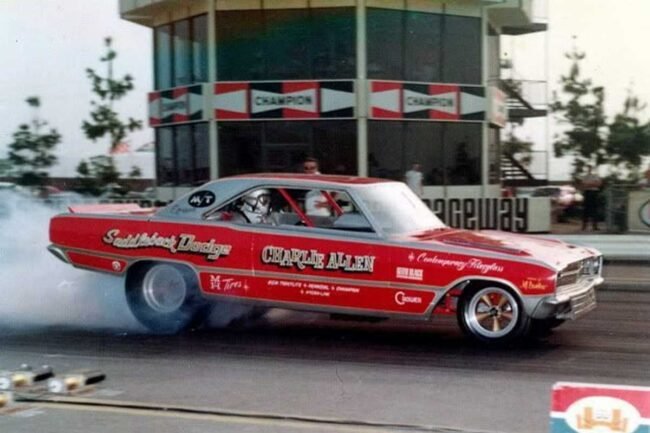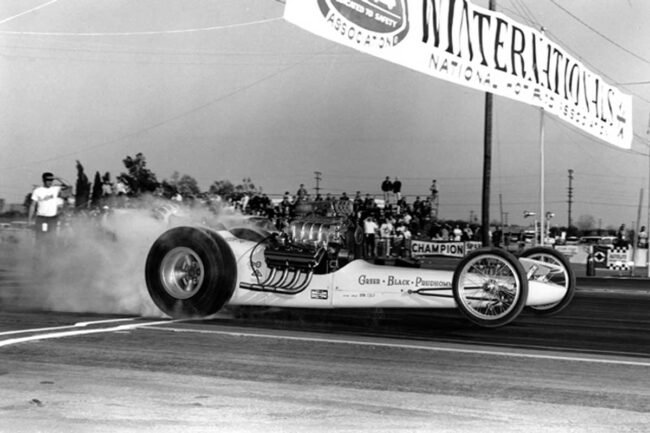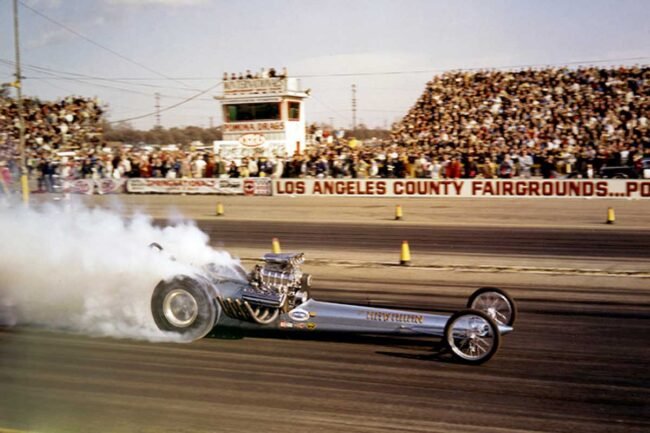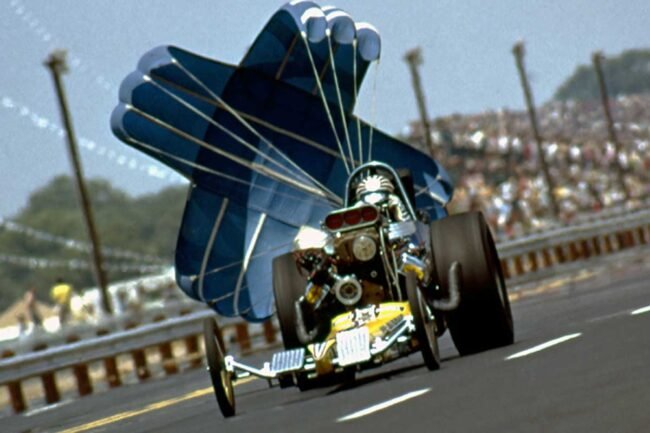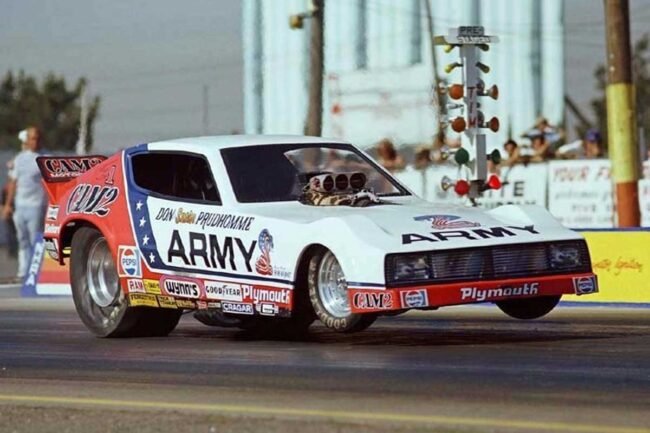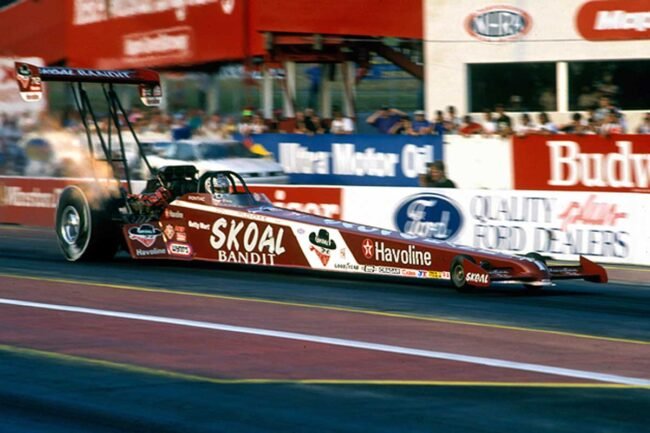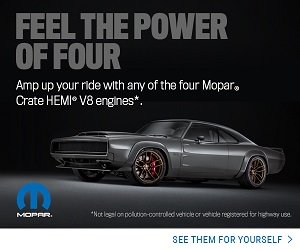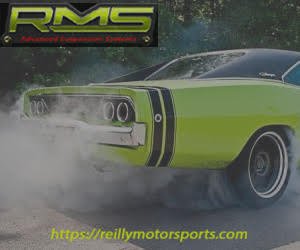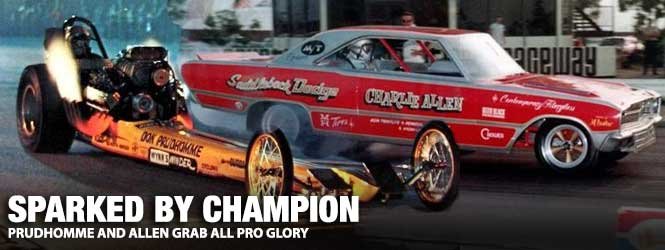
In the August 1969 Hot Rod magazine, a Champion spark plug advertisement stated the All Pro Championship event “featured an array of top drivers in hot competition for a bulging pot of All Pro Gold.” Champion celebrated the wins of Don “the Snake” Prudhomme (Top Fuel) and Charlie Allen (Funny Car), both running Hemis, at the event run at Orange County International Raceway (OCIR).

Above: Don Prudhomme and Charlie Allen finished at the top of the heap of their respective classes. Both drivers insisted on Champion spark plugs. Champion stated their plugs are the heart of a tune-up!
Charlie Allen may not be a household name for many because he ended his driving career over fifty years ago. Allen started his drag racing career in 1963 in a Super Stock Dodge. He continued to progress through the ranks, including factory experimental (FX) in 1964 and an altered wheelbase Dart in 1965.
By 1968, Allen had a tube chassis, flip-top funny car. For the 1969 Nationals in Indy, Allen arrived with a 1970 Challenger, which was soon after outdated (too broad and too heavy) with a few changes to the rules by the National Hot Rod Association (NHRA).
Above: Charlie Allen raced from the early 1960s through 1971. Of all his Mopars, his 1967-69 flip-top Darts have remained his most famous. They incorporated a beautiful simulation of a Dart body mixed with Nitro Hemi power.
Because 1970 was the worst year of his career due to the rules changes, Allen put together a 1971 Charger to meet the NHRA rules. It was narrowed, channeled, and chopped. The Charger was competitive, but a tired Allen permanently hung up his helmet at the end of the season.
Long after his retirement, the Dart funny cars have become Allen’s most famous cars out of all the vehicles he ran. Interestingly, Allen was sponsored through the Dodge public relations group throughout his racing career rather than through the Chrysler race program.
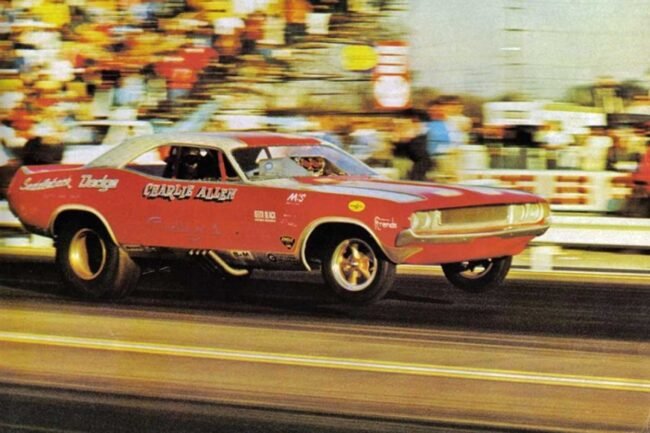
Above: Allen picked up a Challenger funny car for 1970. He got it before the 1969 U.S. Nationals. Unfortunately, NHRA rule changes quickly outdated the Challenger. It was too wide and too heavy to be competitive at the national level.
Allen worked as a contractor after he ended his racing career. In late 1979, he purchased the Orange County International Raceway (OCIR), located in California. He ran the track from 1980 until its demise at the end of 1983 when the landowners decided not to renew the contract agreement.
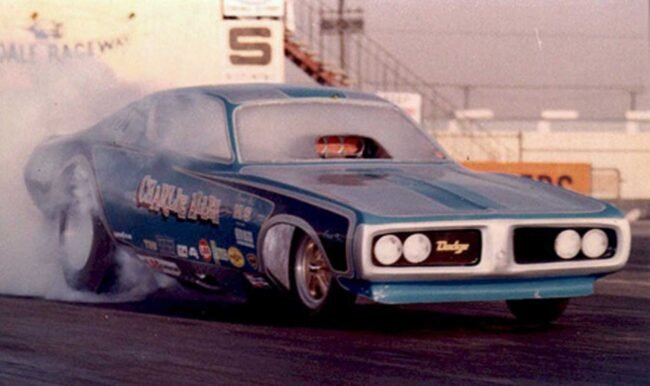
Above: In 1971, Allen built a “mini-Charger,” which effectively followed the NHRA rulebook. The Charger was chopped, channeled, and narrowed. Allen had success with the Charger, but he ended his drag racing career at the end of the season. (Drag Race Memories photo)
When OCIR was nearing its demise, Allen built and operated Firebird International Raceway (FIR), located in Chandler, AZ. FIR was an early prototype of the super tracks that would arrive later in the 1980s. The track had a drag strip, a dirt track, and a lake for boat drag racing. After 30 years of operation, the track closed in 2013, and Allen settled into retirement after five decades of being involved with drag racing.
Above Left: Don Prudhomme had his first great success on nitromethane with the Greer, Black, and Prudhomme dragster. For a few years in the early-to-mid 1960s, it was a terror on the west coast. Above Right: After the demise of the Greer, Black, Prudhomme team, Prudhomme teamed up with Roland Leong and his Hawaiian dragster.
Don Prudhomme does not need an introduction. First, he started helping out “TV” Tommy Ivo and by the early ‘60s was running a gas dragster. Then, in 1962, Prudhomme teamed up with Tommy Greer and Keith Black to field the famous and dominant Greer, Black, and Prudhomme (GB&P) dragster, which was a heavy hitter on the west coast.
After GB&P broke up before the 1965 season, Prudhomme took his talents and teamed up with Roland Leong in his Hawaiian dragster. Leong and Prudhomme won the 1965 Winternationals for Prudhomme’s first of 49 NHRA trophies right out of the gate. The two went on to win the U.S. Nationals later in the year.
Above Left: Now the owner of his team, Prudhomme’s Wynn’s Winder front engine dragster was the dragster he used to win the All Pro Championship. Above Right: In 1970, Prudhomme had Mattel Hot Wheels sponsorship for his dragster and the more popular funny car.
1966 was not as good of a year when compared to 1965. There were still wins, but the wins were fewer and more spread out. In 1967, Prudhomme switched to Ford Hemi power and ran the Baney-Prudhomme dragster. For 1968 and part of 1969, Prudhomme teamed up with Carroll Shelby to race the Shelby Super Snake dragster.
Above Left: Prudhomme’s most successful years were in the mid-1970s when he won four Winston championships (1975-1978). The Plymouth Arrow funny car was one of the most beautiful cars of the era. Above Right: Prudhomme ended his career with the “Final Strike” tour. It was one of his most successful seasons in years.
The Champion advertisement represents Prudhomme’s first dragster he ran on his own. The beautiful yellow dragster called the Wynn’s Winder ran the more familiar, in Nitro racing, Chrysler Hemi. Soon, Prudhomme would team up with Tom “the Mongoose” McEwen with the first non-automotive sponsor. Mattel, the Hot Wheels cars producer, sponsored Prudhomme’s and McEwen’s Funny Cars (and their dragster when they raced them).
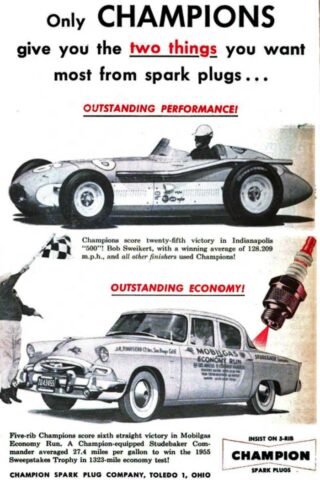
Above: Champion has been in business for 115 years. For more than half those years, Champion has run advertisements that focus on motorsports performance. Occasionally, it showed the benefits of their plugs in economy testing, which, at the time of this ad, Champion had won six years in a row.
Prudhomme and McEwen continued the Hot Wheels sponsorship, then, for a year, had Carefree Gum sponsorship painted on the sides of their Mopars. For 1974, the team had broken up, and Prudhomme moved on to the Army sponsorship. The mid-to-late-1970s was his most dominant era, winning four Winston Funny Car championships in four years.
Prudhomme continued driving funny cars sponsored by Pepsi and then Skoal. Finally, he ended his driving career in 1994, back in a Top Fuel dragster. One of his replacement drivers, Larry Dixon, captured several more championships before Prudhomme packed it in and retired from the sport.

Above: Although known for its spark plugs, Champion has expanded its business to filtration (air, fuel, cabin), batteries, and lighting products.
Champion, a world leader for 115 years in manufacturing spark plugs for all internal combustion engines, has expanded its business to include filters (oil, air, and cabin), batteries, and vehicle lighting.
Champion oil filters protect engines by locking out harmful contaminants to allow clean oil to flow through the engine. Its air filters stop debris but not air from entering the engine. Champion’s 99% efficient cabin air filters use activated carbon to eliminate exhaust and other foul odors. Champion’s full line of batteries is powered by innovative positive grid technology for optimized battery performance. Lastly, Champion offers LED and HID lighting technology to provide better visibility and increased safety.
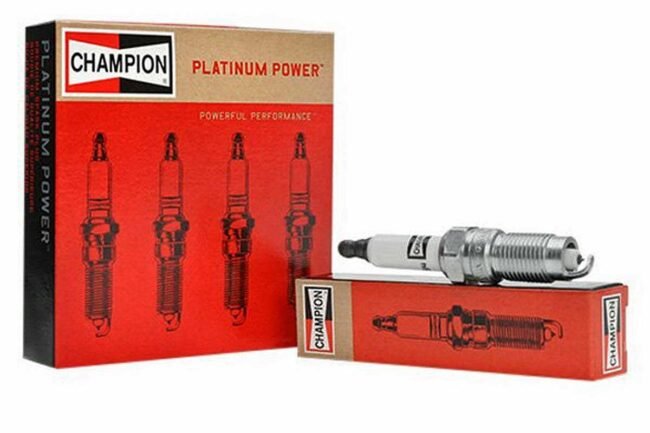
Above: Whether you drive a muscle car or a late-model Mopar, Champion has a plug for you. Champion’s line encompasses four, six, eight, or ten-cylinder wedges, Gen I, II, III Hemis, and pentroof designed combustion chambers.
If you desire Champion products for your Mopar, check out Mancini Racing, Year One, American Muscle, American Trucks, or a local parts store. Remember, if Champion spark plugs are good enough for the professionals, it is an excellent reason to run them in your Mopar.



